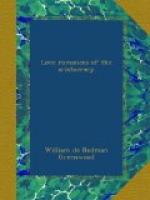Lord Harewood springs from a stock of merchants who accumulated great wealth in the eighteenth century; and Lord Jersey owes much of his riches to Francis Child, the industrious apprentice who, in Stuart days, married the daughter of his master, William Wheeler, the goldsmith, who lived one door west of Temple Bar.
Other peers who count London apprentices among their ancestors are Lord Aveland and Viscount Downe, both descendants of Gilbert Heathcote, whose commercial success was crowned by the Lord Mayoralty in 1711; the Marquis of Bath, a descendant of Lord Mayor Heyward, whose sixteen children are all portrayed in his monument in St Alphege Church, London Wall; and also of Richard Gresham, mercer, who waxed rich from the spoils of the monasteries, and whose son was founder of the Royal Exchange. The Earl of Eldon owes his existence to that runaway exploit which linked the lives of John Scott, the Newcastle tradesman’s son, and Miss Surtees, the banker’s daughter.
If George III. during his lengthy reign only raised one business man to the Peerage, later years have provided a very liberal crop of coroneted men of commerce. To mention but a few of them, banking has been honoured—and the Peerage also—by the baronies granted to Lords Aldenham and Avebury; Lords Hindlip, Burton, Iveagh, and Ardilaun owe their wealth and rank to successful brewing; Baron Overtoun was proprietor of large chemical works; Lord Allerton’s riches have been drawn from his tan-pits; Lord Armstrong’s millions come from the far-famed Elswick engine-works at Newcastle; and Lord Masham’s from his mills at Manningham. The Viscounty of Hambleden has sprung from a modest news-shop in the Strand; the Barony of Burnham was cradled in a newspaper office; and Lords Mount-Stephen and Strathcona were shepherd boys seventy years or more ago, before they found their way through commerce to the Roll of Peers.
Although these lowly origins are as firmly established as Holy Writ, and are in most cases as well known to the noble families who trace rank and riches from them as to the expert in genealogy, they are often as carefully excluded from the family tree as the poor and undesirable relation from the doors of their palaces. Not content with a lineage extending over long centuries, and with a score of strains of undoubted blue blood, many of our greatest nobles and oldest gentle families strain after an ancestry which is not theirs, and throw overboard some obscure forefather to find room for a mythical Norman marauder, who in many cases exists nowhere but in the place of honour on their own pedigrees.
“What are pedigrees worth?” asks Professor Freeman. “I turn over a ‘Peerage’ or other book of genealogy, and I find that, when a pedigree professes to be traced back to the times of which I know most in detail, it is all but invariably false. As a rule it is not only false, but impossible. The historical circumstances, when any are introduced, are for the most part not merely fictions, but exactly that kind of fiction which is, in its beginning, deliberate and interested falsehood.”




